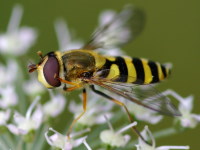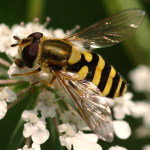Phylum Arthropoda (Arthropods) ➔ Subphylum Hexapoda (Hexapods) ➔ Class Insecta (Insects) ➔ Order Diptera (True flies) ➔ Family Syrphidae (Hoverflies)
Syrphus vitripennis Meigen, 1822
Kleine Schwebfliege
Synonyms and other combinations:
Scaeva confinis Zetterstedt, 1838 | Syrphus agitatus Matsumura, 1918 | Syrphus akakurensis Matsumura, 1917 | Syrphus campestris Matsumura, 1918 | Syrphus candidus Matsumura, 1918 | Syrphus chujenjianus Matsumura, 1917 | Syrphus conspicuus Matsumura, 1918 | Syrphus dubius Matsumura, 1918 | Syrphus kitakawae Matsumura, 1918 | Syrphus kuccharensis Matsumura, 1918 | Syrphus kushirensis Matsumura, 1918 | Syrphus okadensis Matsumura, 1918 | Syrphus palliventralis Matsumura, 1918 | Syrphus shibechensis Matsumura, 1918 | Syrphus strandi Duda, 1940 | Syrphus tenuis Matsumura, 1918 | Syrphus topiarius Meigen, 1822 | Syrphus tsukisappensis Matsumura, 1917 | Syrphus velox Matsumura, 1918 |
Classification:
Syrphus vitripennis belongs to the subfamily Syrphinae, tribe Syrphini.Distribution:
Throughout most of the Palaearctic region, including North Africa; in North America from Alaska to California; Formosa.Habitat:
Most types of deciduous and coniferous forest, also in open biotops.The anthropophilic species occurs in parks, gardens and along field hedges.
Description:
Body length 7.5 - 11 mm; abdomen with a pair of yellow spots on tergit 2 and yellow transverse bands on tergits 3 and 4; eyes bare; face yellow; antennae reddish brown; femora black at the base. Female: hind femora 2/3 black. Male: hind femora 2/3 ... 3/4 black, hind femora outside at the apex with small yellow hairs.Similar species:
There are some similar looking species. The most similar are Syrphus torvus and the Summer Fly Syrphus ribesii. Syrphus torvus has hairy eyes, in contrast to Syrphus ribesii and Syrphus vitripennis. The females of Syrphus vitripennis can be distinguished from those of the similar Summer Fly Syrphus ribesii by the color of the hind femora. These are yellow in Syrphus ribesii. The males are not clearly distinguishable from photos. The hind femora of Syrphus ribesii males are at least half black colored at the base and have small black hairs at the tip.Biology:
Syrphus vitripennis flies probably in several generations from April to October. The species is highly migratory.The adults feed on pollen and nectar and visit the flowers of white umbellifers, Brassica rapa, creeping bellflower (Campanula rapunculoides), Cirsium, hawthorn (Crataegus), blackberries (Rubus fruticosus) and other plants. Males hover at 2 - 5 m beside trees and shrubs and chase away other flies.
After mating, the females lay their eggs on trees, shrubs and herbaceous plants that are infested by aphids. The entire development from egg to imago takes about 20-40 days. The polyphagous larvae of Syrphus vitripennis feed on many different aphid species. They pass through 3 larval stages and eat 460 to 1100 aphids, depending on the availability, species, size and stages of development of the prey.
The mature larva has an optional diapause and overwinters in the litter layer.
References, further reading, links:
- Pape T. & Thompson F.C. (eds) (2017). Systema Dipterorum (version 2.0, Jan 2011). In: Species 2000 & ITIS Catalogue of Life, 2017 Annual Checklist (Roskov Y., Abucay L., Orrell T., Nicolson D., Bailly N., Kirk P.M., Bourgoin T., DeWalt R.E., Decock W., De Wever A., Nieukerken E. van, Zarucchi J., Penev L., eds.). Digital resource at www.catalogueoflife.org/annual-checklist/2017. Species 2000: Naturalis, Leiden, the Netherlands. ISSN 2405-884X.
- Gerald Bothe: Bestimmungsschlüssel für die Schwebfliegen (Diptera, Syrphidae) Deutschlands und der Niederlande, DJN, 1984, ISBN 3-923376-07-3
- M.C.D.Speight: Species Accounts of European Syrphidae (Diptera), Glasgow 2011, Syrph the Net, the database of European Syrphidae, vol. 65, 285 pp., Syrph the Net publications, Dublin.
- Menno Reemer, Willem Renema, Wouter van Steenis, Theo Zeegers, Aat Barendregt, John T. Smit, Mark P. van Veen, Jeroen van Steenis, Laurens van der Leij: De Nederlandse Zweefvliegen (Diptera: Syrphidae), Nederlandse Fauna 8, 2009.
- Anasimyia interpuncta
- Anasimyia transfuga
- Baccha elongata
- Blera fallax
- Brachyopa sp.
- Brachypalpoides lentus
- Brachypalpus laphriformis
- Brachypalpus sp.
- Brachypalpus valgus
- Ceriana conopsoides
- Ceriana vespiformis
- Chalcosyrphus femoratus
- Chalcosyrphus nemorum
- Chalcosyrphus valgus
- Cheilosia albipila
- Cheilosia albitarsis
- Cheilosia chrysocoma
- Cheilosia illustrata
- Cheilosia pagana
- Cheilosia scutellata
- Cheilosia sp.
- Cheilosia variabilis
- Chrysogaster sp.
- Chrysotoxum bicinctum
- Chrysotoxum fasciatum
- Chrysotoxum festivum
- Chrysotoxum verralli
- Criorhina berberina
- Dasysyrphus albostriatus
- Dasysyrphus sp.
- Dasysyrphus tricinctus
- Didea fasciata
- Didea intermedia
- Didea sp.
- Epistrophe diaphana
- Epistrophe eligans
- Epistrophe flava
- Epistrophe grossulariae
- Epistrophe melanostoma
- Epistrophe melanostoma/nitidicollis
- Epistrophella euchroma
- Episyrphus balteatus
- Eristalinus aeneus
- Eristalinus megacephalus
- Eristalinus taeniops
- Eristalis arbustorum
- Eristalis interrupta
- Eristalis intricaria
- Eristalis lineata
- Eristalis pertinax
- Eristalis rupium
- Eristalis similis
- Eristalis sp.
- Eristalis tenax
- Eumerus purpurariae
- Eumerus sp.
- Eupeodes corollae
- Eupeodes luniger
- Eupeodes sp.
- Eurimyia lineata
- Ferdinandea cuprea
- Hammerschmidtia ferruginea
- Helophilus hybridus
- Helophilus pendulus
- Helophilus sp.
- Helophilus trivittatus
- Ischiodon aegyptius
- Leucozona glaucia
- Leucozona laternaria
- Leucozona lucorum
- Melangyna lasiophthalma
- Melangyna quadrimaculata
- Melangyna umbellatarum
- Melanogaster sp.
- Melanostoma scalare
- Meligramma triangulifera
- Meliscaeva cinctella
- Merodon ambiguus
- Merodon avidus
- Merodon equestris
- Merodon moenium
- Merodon obscuritarsis
- Merodon sp.
- Microdon analis/major
- Microdon mutabilis/myrmicae
- Myathropa florea
- Myolepta dubia
- Orthonevra sp.
- Paragus sp.
- Parasyrphus lineolus
- Parhelophilus sp.
- Pipiza austriaca
- Pipiza bimaculata
- Pipiza fenestrata
- Pipiza quadrimaculata
- Pipiza sp.
- Platycheirus rosarum
- Platycheirus sp.
- Rhingia campestris
- Rhingia rostrata
- Scaeva albomaculata
- Scaeva pyrastri
- Scaeva selenitica
- Sericomyia lappona
- Sericomyia silentis
- Sphaerophoria rueppelli
- Sphaerophoria scripta
- Sphaerophoria sp.
- Sphegina sp.
- Spilomyia saltuum
- Syritta pipiens
- Syrphus ribesii
- Syrphus sp.
- Syrphus vitripennis
- Temnostoma bombylans
- Temnostoma meridionale
- Temnostoma vespiforme
- Tropidia scita
- Volucella bombylans
- Volucella inanis
- Volucella inflata
- Volucella pellucens
- Volucella zonaria
- Xanthogramma citrofasciatum
- Xanthogramma pedissequum
- Xylota segnis
- Xylota sp.
- Xylota sylvarum

